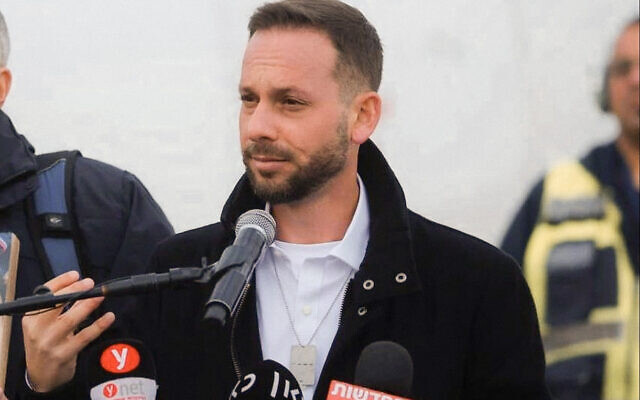It was Valentine’s Day when Meta’s ad platform started going off the rails. RC Williams, the co-founder of the Philadelphia-based marketing agency 1-800-D2C, had set one of Meta’s automated ad tools to run campaigns for two separate clients. But when he checked the platform that day, he found that Meta had blown through roughly 75 percent of the daily ad budgets for both clients in under a couple of hours.
On the morning of Saturday, October 7, Haim Rubinstein heard the sirens go off at his home in Tel Aviv. He turned the television on and saw Hamas terrorists getting off a white pickup truck in Sderot and then watched social media footage of Israelis being kidnapped to the Gaza Strip.
Rubinstein understood instantly that these events were unprecedented, and that immediate action was needed.
He saw the first hostages being dragged away on foot, in pickup trucks and on motorcycles — including Noa Argamani, who was kidnapped from the Supernova music festival near Kibbutz Re’im aboard a motorcycle while crying for help, with her boyfriend Avinatan Or led away on foot by terrorists.
Rubinstein, 35 — an experienced media adviser who had previously served as spokesman for former Yesh Atid MK Ofer Shelah and as a member of the party’s media team in four election campaigns — told his partner Roni: “I can no longer sit around.”
“The first thing I did was pick up the phone a few minutes after 8 a.m. and tell my clients that I had decided to take time off to help the hostages’ families,” Rubinstein told Zman Yisrael, The Times of Israel’s Hebrew-language sister site, in an interview this week.
On the same day that Hamas-led terrorists killed some 1,200 people in Israel and took 253 people hostage into Gaza, Rubinstein and his partner began collecting names of hostages who were identified in news reports and on social media. By the end of that bloody Saturday, he had already gathered 70 names.
On Sunday, Rubinstein began meeting with relatives of the abductees. One of those he met was Moshe Or, Avinatan Or’s brother.
“Moshe told me something that still echoes in my ears, to this day,” Rubinstein recalls. “He told me, ‘We don’t need anything. They’ll be back within two days.’ I said I didn’t believe that would be the case.”
By the end of that day, Rubinstein had an initial list of some 250 hostages and missing people, and he put together a list of their relatives so that he could stay in touch with them.
Within days, this private initiative expanded to what became known as the Hostages and Missing Families Forum. Rubinstein assumed the role of the Forum’s spokesperson.
“In the first meeting with the family members, some of them were in shock and had a hard time stomaching the fact that their kids had been kidnapped,” Rubinstein recalls. “I promised to get them anything they needed from an organizational perspective so that they could focus on the fight to get their children released quickly.

Composite of hostages held in Gaza by Hamas after the invasion of 3,000 terrorists into Israel on October 7, 2023, in which 1,200 people were slaughtered and some 250 taken captive. (Courtesy the Kidnapped From Israel campaign website/ Dede Bandaid, Nitzan Mintz & Tal Huber. Designed by Shira Gershoni & Yotam Kellner)
“People asked me all sorts of questions. For instance, one of the parents showed me a Hamas-issued video showing one of the hostages, but it was blurry and they had a hard time determining whether it was their daughter, so they wanted a professional to clean up the picture.”
Rubinstein resigned last month as the Forum’s spokesman. This is the first time since that he’s agreed to share his almost six-month-long experience – and to explain why he felt he had to leave the Forum that he had co-founded.
The following interview has been translated and edited from Hebrew.
Did the families whose sons and daughters were taken hostage while serving in the IDF get updates from the army?
“In the first few days, these families didn’t know who to turn to. The IDF was unprepared, and some families didn’t get information from a government-authorized party for two weeks.
“We started to independently collect information about each hostage and set up a website.”

Noa Argamani is seen being kidnapped by Hamas terrorists during the massacre at the Supernova desert rave in the south on October 7, 2023. (Screenshot used in accordance with clause 27a of the copyright law)
Did you work with Gal Hirsch or with the Prime Minister’s Office? (On October 8, Prime Minister Benjamin Netanyahu appointed Hirsch to act as the coordinator between the families and the government. Rubinstein contends that, at the time, Hirsch’s team didn’t have comprehensive information regarding the number of hostages.)
“Gal Hirsch only began functioning after two or three weeks. Until then, there was no one to talk to. I don’t know what his contribution was. As far as I can tell, he just held the microphone in meetings with the families. He told them they shouldn’t hold protests [to push for their loved ones’ release].
“You need to understand that Netanyahu set up Hirsch’s team because the Prime Minister’s Office didn’t want there to be an external body criticizing the government for its conduct surrounding the hostages.”
Who did you meet with to advance the hostages’ return?
“The first official we met was President Isaac Herzog. It was on October 10. At the time, the reported death toll from the attack was only 400. We asked him to use his influence so that there would be someone in the government taking care of the families.”

Gal Hirsch, the government’s point man on missing and kidnapped citizens, left, speaks to a relative of a captive Israeli ahead of a meeting with families of Israelis held hostage by Hamas terrorists in Gaza and Israelis who were released from Hamas captivity in Herzliya, December 5, 2023. (Avshalom Sassoni/Flash90)
When did the prime minister meet the hostages’ families for the first time?
“On October 15. Until then, there had been no meeting with him or anyone on his behalf.”
Did you feel like the government was ignoring you?
“Absolutely. No representative of the government or the IDF had updated the families of the hostages that the IDF was beginning its ground offensive in the Gaza Strip. We couldn’t understand how it could be that the families weren’t getting updated on the ramifications this could have for them.”
How did you deal with this?
“On that day, October 26, I called on the families to come to Hostages Square in Tel Aviv. At the assembly, we announced that the prime minister and the defense minister must meet the families, but there was no response to that from Netanyahu’s or Yoav Gallant’s offices.
“So we said that if we didn’t get an immediate response, the families would camp outside the Kirya IDF headquarters in Tel Aviv.
“After that, Gallant promised in a statement to meet the families the next day. We told him we weren’t willing to wait. That evening, Netanyahu’s office announced that he would meet the families’ representatives.”

Prime Minister Benjamin Netanyahu meets with family members of hostages held by Hamas, in Jerusalem, January 22, 2024. (PMO Spokesperson)
What was the atmosphere like?
“We left the meeting very disappointed because Netanyahu talked about dismantling Hamas as the goal of the war. He didn’t promise anything regarding the demand to return the hostages. He merely said a military operation in Gaza was needed to serve as leverage for the hostages’ release.
“We later found out that Hamas had offered on October 9 or 10 to release all the civilian hostages in exchange for the IDF not entering the Strip, but the government rejected the offer.”
Did Benny Gantz and Gadi Eisenkot support your effort or were they not active on that front? (Five days after the war began, the centrist opposition National Unity party joined the emergency government, with its leader Gantz getting a spot on the three-member war cabinet and MK Eisenkot becoming an observer in the key decision-making panel. Both Gantz and Eisenkot are former IDF chiefs of staff.)
“We worked with them all the time. Any time we wanted to meet with them, they agreed. They pressured Netanyahu to make a deal, but Netanyahu sidelined them. The families are still asking Gantz not to leave the government” — as many government critics have increasingly been urging them to do.”
How come the first hostage deal was relatively quick (53 days since the war began), but the second deal has been pushed off for over 200 days? (Rubinstein said he has “no doubt” that a protest march to Jerusalem that he organized brought about the November deal in which over 100 women and children were released in exchange for a week-long truce and Israel freeing female and underage Palestinian security prisoners.)
“The main reason is the prime minister’s refusal. On the one hand, Netanyahu has told the families that the price” — likely the release of countless Palestinian terror convicts — “isn’t a factor. On the other hand, he’s holding onto all sorts of security excuses to prevent a deal.”

File: Far-right leaders Itamar Ben Gvir and Bezalel Smotrich at the Knesset on December 29, 2022. (Yonatan Sindel/Flash90)
How do you explain Netanyahu’s ostensible lack of effort to bring the hostages home?
“The main reason is conflict of interest. He knows that the moment the hostages are released, Bezalel Smotrich and Itamar Ben Gvir will leave the government because they’ll think the price was too high.” (Finance Minister Smotrich, leader of the Religious Zionism party, and National Security Minister Ben Gvir, head of the Otzma Yehudit party, are far-right leaders essential to Netanyahu’s coalition and have been pushing for stronger military action in Gaza.)
“There is no doubt that Netanyahu is preventing a deal. Netanyahu knows that if he goes to elections at this time he won’t be able to form a new government, and he is motivated by cold political considerations.”
Do you agree with those arguing that every day that passes reduces the chances of the hostages coming home?
“Unfortunately, it’s worse than that. Time is not running out — time has already run out. Many hostages, even those who will come back alive, will need very complex rehabilitation because they’ve been in captivity and under very complex conditions for many months.”
Why did you resign as the families’ spokesman, a role you defined as the project of your lifetime?
“After five months of 24/7 work for the families, my own family needed me. There were also other reasons, such as the Prime Minister’s Office’s meddling in the Hostages and Missing Families Forum, in an attempt to divide [the families].”
(Some families have started to openly call on Netanyahu and his government to resign, while other families reject those messages. Rubinstein rejected claims leveled against him of “politicizing” the hostage families’ cause: “The opposite is true: Netanyahu’s people were the only ones making it political.”)

A protester holds a sign reading ‘Netanyahu’s survival or the survival of the hostages’ at a Tel Aviv protest calling for early elections and the release of the hostages from Gaza, April 6, 2024. (Lior Segev/Pro-Democracy Protest Movement)
Is it correct that there have also been threats against you?
“That’s right. There were threats to tarnish my name, but this isn’t the time to talk about it. At this time, the only focus should be on returning the 133 hostages who are rotting away in Hamas’s tunnels.”
—
In response to Rubinstein’s claims, the Prime Minister’s Office stated that “the prime minister, together with the security and diplomatic leadership, are working around the clock and doing everything possible to bring the hostages home.”
Gal Hirsch’s office commented: “Hirsch was appointed by the prime minister the day after the war broke out. The apparatus he set up began working in the first week of the war and has steadily continued to build and improve from day to day.
“The hostages apparatus is continuously acting in coordination with all security bodies, government ministries and international officials, and this action shall continue in order to return the hostages and help their families in their darkest hour.”

